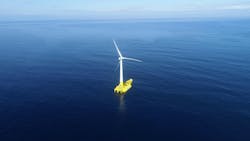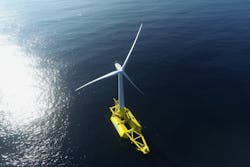Floating wind demonstration project could encourage further investments, developments
Editor's note: This feature first appeared in the March-April 2024 issue of Offshore magazine. Click here to view the full issue.
By Ariana Hurtado, Editor and Director of Special Reports
Partners RWE, Saitec Offshore Technologies and The Kansai Electric Power Co. Inc. (KEPCO) have been collaborating on a commercial-scale floating wind project offshore Spain. It all began with the Saitec-developed SATH concept, which is a concrete twin-hull barge structure made of modular, pre-fabricated components. The design has a single point of mooring, aligning itself to the current and wave direction. This technology led to the partners' DemoSATH demonstration project offshore Spain.
In August 2023, DemoSATH was installed offshore at the BiMEP testing area at Armintza in the Basque Country. The project, which achieved first power in September 2023, uses a 2-MW turbine that was assembled in the port of Bilbao. The platform, including the turbine, is still located at the BiMEP test site, which is 2 miles off the Basque coast with a water depth of 85 m. Hybrid mooring lines, composed of chains and fiber, anchored to the seabed hold the unit in position.
"DemoSATH has a fully operation monitoring system providing feedback on all the engineering levels of the platform, ranging from structural health monitoring, platform global dynamics, wind turbine performance, among the most relevant," Marc Batlle, Saitec's head of hydrodynamic engineering, told Offshore. "This data is being used to validate the existing numerical models, to understand possible scale effects during the experimental campaigns and provide further insights of the full-scale technology performance for future developments."
The project will be operational for two years, as the partners gather data about the behavior of the SATH technology and the monitoring of the systems installed on the platform to understand its interaction with the nearby ecosystem.
Challenges
It's been a few months since operations began on the DemoSATH project, and Saitec's Batlle and Irati Larrinaga, foundation package lead engineer, discussed with Offshore the lessons learned since the project commenced.
"The project is a unique opportunity for gaining further understanding of the performance of a real-scale prototype in harsh conditions," Larrinaga said. "The lessons learned are invaluable, providing real-world data on its performance, allowing us to refine procedures for towing, hook-up, station keeping and dynamic cable deployment. This translates to smoother operations and improved efficiency in the future."
Batlle added, "We are excited about comparing real-time data with our existing models that help us to validate our design and identify potential areas for further optimization. We're encouraged by the strong correlation observed so far, affirming the effectiveness of our strategic approach."
The Saitec team also has expanded its knowledge regarding the necessary permits, construction methodologies and supply chain management. The company said it has concentrated on engaging stakeholders and developing a communication strategy with the local community and society at large.
Uncontrollable variables outside the DemoSATH project itself affected the team's initial progress.
"The most significant challenges encountered by the project were tied to a series of major global events that unfolded during its execution phase," Batlle said. "These included the pandemic, the Suez Canal blockage, the war in Ukraine, and various strikes, all of which had cascading effects such as inflation, price volatility, delivery delays and shortages in inventory. Undertaking a prototype project is inherently demanding, but the exceptional circumstances surrounding this project's development period highlighted the Saitec team's remarkable resilience and capability to navigate these challenges and achieve commercial operation date successfully."
This project is located in rougher waters compared to floating wind turbines elsewhere around the world. To address this and ensure success, Saitec said the platform has been designed to withstand site specific conditions as those observed in the BiMEP area.
"For this, historical metocean data provided by BiMEP has been very useful and a great source of quality measurements that allowed to characterize extreme metocean conditions," Larrinaga said. "The platform in such conditions has proven, in the numerical models and various experimental test, to behave according to the engineering criteria."
2024 project milestones
September 2024 will mark one year since DemoSATH was commissioned, which Saitec believes will be an important milestone for both the technology and the industry in general.
"This date will also be a good opportunity to take stock of the results obtained during the first year of production, such as the total energy generated, the lessons learned, and the hours of production and downtime that have occurred throughout the year," Larrinaga added.
In addition, a research project agreement has been signed between France Energy Marine (FEM) and Saitec, in which the two are collaborating on the development of a digital twin and for in-depth monitoring that will allow the comparison of simulation models and real-time measurements at sea.
"All of this will serve to be able to implement improvements for future projects and to get to know in a better and real way how this disruptive technology works," Batlle said.
In addition, the prototype certification seal will be granted to the project in the coming months.
Looking ahead
Batlle described DemoSATH as a "demonstration of the feasibility and viability of floating offshore wind technology" and said the project could potentially encourage additional investments and developments in the renewable energy sector in Spain and worldwide.
"The project also has introduced floating offshore wind technology as a new renewable generation source in Spain's energy mix," Batlle continued. "This represents a significant milestone in diversifying Spain's energy sources and reducing reliance on traditional fossil fuels. Its connection to the Spanish electrical grid is generating sufficient electricity to cover the energy demand of over 2,500 households in a year."
According to Saitec, the DemoSATH project began and will conclude with the validation of a full-scale demonstrator of SATH technology, and there are no plans to expand the project by installing other turbines of these characteristics.
"However, Saitec is already working on promoting a pre-commercial wind farm—the GEROA [Green Energy Research for Offshore Atlantic] project—with a maximum installed capacity of 50 MW with the aim of continuing to demonstrate the technical, economic and environmental feasibility of SATH technology using turbines of greater power 15-16 MW," Larrinaga said.
The GEROA project is expected to be the first wind farm offshore Spain with three to five turbines using SATH floating offshore wind technology.
Larrinaga added, "Although this project does not belong to the DemoSATH project itself, it can be considered an extension of it, since the area in which it will potentially be installed is very close to the 2-MW demonstrator, thus indicating that the metocean conditions to which will be exposed will be practically the same as in the smaller unit."
This project is currently in the environmental impact study development phase and is planned to come into operation in September 2027.
About the Author
Ariana Hurtado
Editor-in-Chief
With more than a decade of copy editing, project management and journalism experience, Ariana Hurtado is a seasoned managing editor born and raised in the energy capital of the world—Houston, Texas. She currently serves as editor-in-chief of Offshore, overseeing the editorial team, its content and the brand's growth from a digital perspective.
Utilizing her editorial expertise, she manages digital media for the Offshore team. She also helps create and oversee new special industry reports and revolutionizes existing supplements, while also contributing content to Offshore's magazine, newsletters and website as a copy editor and writer.
Prior to her current role, she served as Offshore's editor and director of special reports from April 2022 to December 2024. Before joining Offshore, she served as senior managing editor of publications with Hart Energy. Prior to her nearly nine years with Hart, she worked on the copy desk as a news editor at the Houston Chronicle.
She graduated magna cum laude with a bachelor's degree in journalism from the University of Houston.


